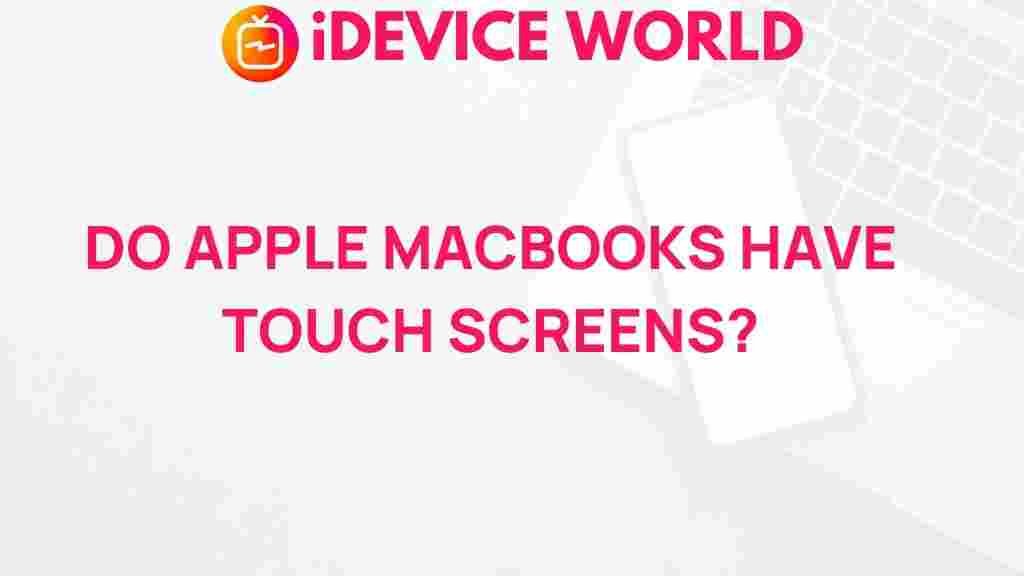Apple: Do MacBooks Sport Touch Screens?
When it comes to premium laptops, Apple has set the standard with its MacBook line. Renowned for their sleek design, powerful performance, and intuitive user experience, MacBooks have become a popular choice among professionals and creatives alike. However, one question continues to intrigue potential buyers: do Apple MacBooks sport touch screens? This article dives deep into this topic, exploring the features of MacBooks, the rationale behind Apple’s design choices, and the future of touch technology in their laptops.
Understanding the MacBook Lineup
Before addressing the touch screen question, it’s essential to understand the different models within the MacBook lineup:
- MacBook Air: The lightweight champion, ideal for everyday tasks.
- MacBook Pro: A powerhouse for professionals, available in 13-inch, 14-inch, and 16-inch sizes.
Each model offers a unique set of features tailored to specific user needs, from portability to performance. However, a common characteristic across the range is the absence of touch screen functionality.
The Touch Screen Debate
The question of whether Apple will integrate touch screens into their MacBook lineup has been a hot topic among users. While many Windows laptops now come equipped with touch screens, Apple has remained steadfast in its decision against this feature. Let’s explore the reasoning behind this choice:
1. User Experience Philosophy
Apple’s design philosophy emphasizes simplicity and usability. The company believes that a touch screen may complicate the user experience on laptops. Unlike tablets and smartphones, where touch interaction is intuitive, Apple argues that a trackpad and keyboard offer more precision and comfort for tasks such as typing and graphic design.
2. Consistency Across Devices
Apple has created an ecosystem of devices, including the iPhone, iPad, and MacBook, each optimized for different forms of interaction. For instance, iPads feature touch screens and can be paired with keyboards, blurring the lines between tablets and laptops. By keeping the MacBook’s interface separate, Apple maintains clarity in how each device is intended to be used.
3. Technical Limitations
Integrating touch screens into MacBooks would require significant changes to their hardware and software. The touch screen technology used in iPads and iPhones is different from traditional laptop displays. Apple may also prioritize maintaining the MacBook’s battery life and performance, which could be impacted by the addition of touch functionality.
Current Features and Alternatives
While MacBooks do not have touch screens, Apple offers several features that enhance user interaction:
- Trackpad: The large, responsive trackpad on MacBooks supports gestures that mimic touch interactions, allowing users to swipe, pinch, and scroll intuitively.
- Touch Bar: Some MacBook Pro models include a Touch Bar, a dynamic touchscreen strip that provides shortcuts and controls tailored to the active application.
- Apple Pencil Support: While not for MacBooks, Apple’s iPads support the Apple Pencil, allowing for precise drawing and note-taking.
These features provide a level of interactivity that, while not the same as a touch screen, still enhances productivity and user experience.
The Future of Touch Screens in Apple Products
As technology continues to evolve, the possibility of Apple introducing touch screens to their MacBook lineup remains a topic of speculation. Here are some potential scenarios:
1. Hybrid Devices
Apple might consider developing hybrid devices that blend the functionalities of MacBooks and iPads. Such devices could feature a detachable keyboard and a touch screen, catering to users who seek versatility.
2. Software Improvements
Improvements in macOS could enhance touch-like experiences on MacBooks. Features that allow for more intuitive gestures using the trackpad could mimic touch screen functionality without actually adding a touch display.
3. Consumer Feedback
If consumer demand for touch screens continues to grow, Apple may reconsider its stance. The company often evolves its product lines based on user feedback, so engaging with customer preferences could influence future designs.
Troubleshooting Tips for MacBook Users
If you’re a MacBook user looking to optimize your experience without a touch screen, consider the following tips:
- Customize Trackpad Settings: Go to System Preferences > Trackpad to adjust settings such as tracking speed, gestures, and more.
- Utilize Keyboard Shortcuts: Learn keyboard shortcuts to improve efficiency. Apple provides a comprehensive list on their support page.
- Explore Touch Bar Functions: If you have a MacBook Pro with a Touch Bar, take advantage of the customizable controls to streamline your workflow.
Implementing these tips can enhance your productivity and make your MacBook experience more enjoyable.
Conclusion
In conclusion, while the question of whether Apple MacBooks sport touch screens remains unanswered in the affirmative, it’s crucial to understand the rationale behind this design choice. Apple prioritizes user experience, consistency across devices, and technical feasibility, leading to their decision to exclude touch screens from MacBooks.
As technology advances, the landscape may change, and future MacBooks could incorporate touch functionality. For now, users can enjoy the robust features of MacBooks while leveraging alternatives like trackpads and the Touch Bar to enhance their computing experience. For more information on the latest Apple products, visit Apple’s official website.
For tips and insights on maximizing your MacBook’s potential, check out our guide on best practices for Mac users.
This article is in the category Reviews and created by iDeciveWorld Team
